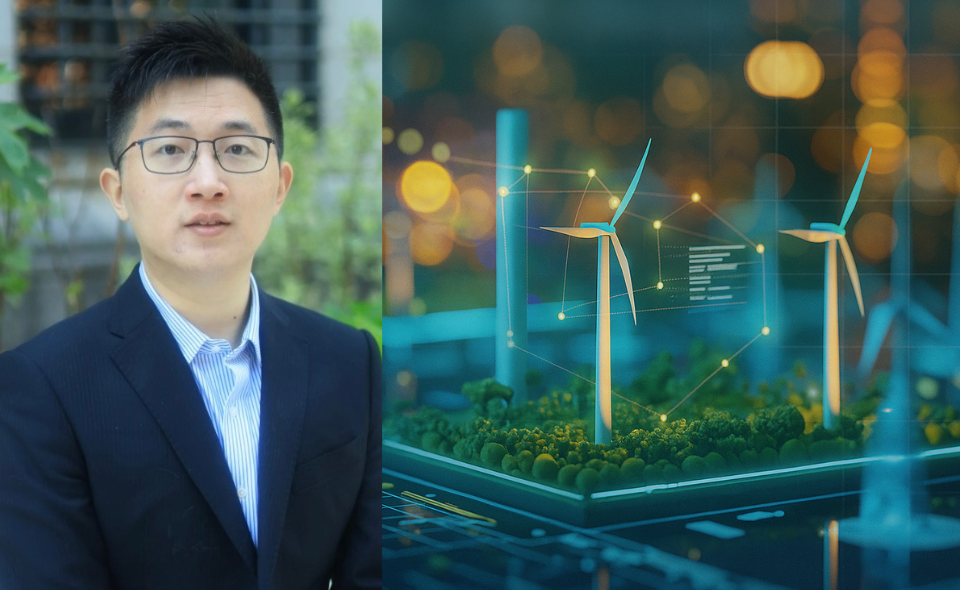

As the global push towards renewable energy continues, the complexity of managing modern power grids has grown dramatically. Variability from solar and wind sources, real-time market fluctuations, and the physical limitations of energy infrastructure demand smarter, more adaptive solutions. AI offers powerful capabilities – especially if its models can account for the physical realities of the systems they aim to control.
At Columbia University’s Data Science Institute, postdoctoral researcher Ming Yi is addressing this challenge head-on. Working at the intersection of AI, systems engineering, and energy science, Yi develops models that incorporate physical constraints and operational decision-making into machine learning frameworks. His research focuses on improving AI models for renewable energy integration, energy market forecasting, and energy system resilience.
“We are moving towards a sustainable future,” Yi explains, “but that transition comes with a lot of hurdles. AI and ML have great potential to support renewable power and energy systems. My major goal is to bridge the gap between AI/ML advances and urgent energy sector needs.”
Integrating Physics into AI Models
Working under the mentorship of Bolun Xu, Assistant Professor of Earth and Environmental Engineering and Gil Zussman, Kenneth Brayer Professor of Electrical Engineering and Chair of the Department of Electrical Engineering, Yi leads a number of projects that address the complex dynamics of modern power infrastructure. His research tackles foundational questions: How can we balance supply and demand in a power grid increasingly powered by intermittent sources like solar and wind? How can AI support real-time energy decisions while respecting the physical constraints and trade-offs inherent to the grid?
AI and ML have great potential to support renewable power and energy systems. My major goal is to bridge the gap between AI/ML advances and urgent energy sector needs.
– Ming Yi“AI enables more accurate forecasting and more responsive control,” Yi explains. “But current models often ignore physical limitations or strategic decision-making complexity.” To address this, Yi has been developing a unique hybrid approach that explicitly incorporates physical constraints – such as battery capacity limits and system reliability thresholds – into AI energy decision-making processes. By embedding physics into AI-based decision-making, Yi’s work advances a new generation of intelligent systems that are both data-driven and physically grounded.
Theory – with Real World Applications
Yi’s recent work exemplifies this vision. In a forthcoming paper for IEEE Transactions on Smart Grid, Yi and his collaborators present a hybrid AI framework that embeds the physics of energy storage into predictive modeling pipelines. The team applied their method to two real-world scenarios: optimizing battery arbitrage in real-time energy markets, and forecasting the behavior of energy storage systems under dynamic price signals. Their results – based on real market data – showed substantial performance gains over existing approaches, both in terms of profitability and predictive accuracy.

Source: Ming Yi, Bolun Xu, and Gil Zussman, “A Physics-Grounded Hybrid AI Framework for Accurate and Risk-Aware Energy Storage Arbitrage under Uncertainty,” arXiv:2406.17085 [eess.SY], 2024.
Such improvements are not only academic. As grid operators and energy storage companies navigate increasingly volatile price environments, they require tools that manage both opportunity and risk. In a study to be presented at the 2025 IEEE Power & Energy Society General Meeting, Yi and his colleagues outline a risk averse approach to energy storage arbitrage that quantifies the uncertainty in price forecasts. Validated using historical New York electricity prices, the approach helps operators maximize profits while avoiding costly errors.
In another real world example, Yi worked with Professor Xu on a project for Red River Clean Energy to forecast electricity prices in Texas’s real time, wholesale ERCOT market. For the project, Yi led a team of PhD and masters students, along with company engineers, to leverage ML for energy storage bidding, processing over 100GB of ERCOT data, and integrating physical constraints into the models for more accurate results.
From Foundational Research to Practical Tools
This integration of data science and operational insight reflects a broader ethos at the Institute: translating foundational research into practical tools that benefit both industry and society. As he looks to the future, Yi remains focused on the intersection of fundamental research and real-world applications. “This is the dream,” he says. “To help build intelligent systems that support a sustainable energy transition – not just in theory, but in practice.”